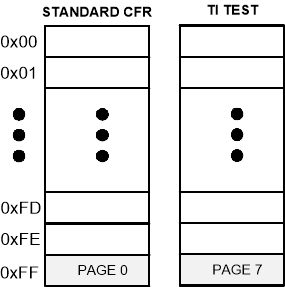JAJSQ80C september 2013 – october 2020 SN65DSI86
PRODUCTION DATA
- 1
- 1 特長
- 2 アプリケーション
- 3 概要
- 4 Revision History
- 5 Description (continued)
- 6 Pin Configuration and Functions
- 7 Specifications
-
8 Detailed Description
- 8.1 Overview
- 8.2 Functional Block Diagram
- 8.3 Feature Description
- 8.4
Device Functional Modes
- 8.4.1 Reset Implementation
- 8.4.2 Power-Up Sequence
- 8.4.3 Power Down Sequence
- 8.4.4 Display Serial Interface (DSI)
- 8.4.5
DisplayPort
- 8.4.5.1 HPD (Hot Plug/Unplug Detection)
- 8.4.5.2 AUX_CH
- 8.4.5.3 I2C-Over-AUX
- 8.4.5.4 DisplayPort PLL
- 8.4.5.5 DP Output VOD and Pre-emphasis Settings
- 8.4.5.6 DP Main Link Configurability
- 8.4.5.7 DP Main Link Training
- 8.4.5.8 Panel Size vs DP Configuration
- 8.4.5.9 Panel Self Refresh (PSR)
- 8.4.5.10 Secondary Data Packet (SDP)
- 8.4.5.11 Color Bar Generator
- 8.4.5.12 DP Pattern
- 8.4.5.13 BPP Conversion
- 8.5 Programming
- 8.6 Register Map
- 9 Application and Implementation
- 10Power Supply Recommendations
- 11Layout
- 12Device and Documentation Support
- 13Mechanical, Packaging, and Orderable Information
8.6 Register Map
Many of the SN65DSI86 functions are controlled by the Control and Status Registers (CSR). All CSR registers are accessible through the local I2C interface or through DSI interface.
Reads from reserved fields not described return zeros, and writes to read-only reserved registers are ignored. Writes to reserved register which are marked with W will produce unexpected behavior.
Table 8-18 Bit Field Access Tag Descriptions
| ACCESS TAG | NAME | MEANING |
|---|---|---|
| R | Read | The field may be read by software |
| W | Write | The field may be written by software |
| S | Set | The field may be set by a write of one. Writes of zeros to the field have no effect. |
| C | Clear | The field may be cleared by a write of one. Writes of zero to the field have no effect. |
| U | Update | Hardware may autonomously update this field. |
| NA | No Access | Not accessible or not applicable |
 Figure 8-14 Register Map
Figure 8-14 Register Map